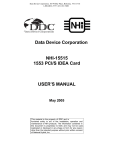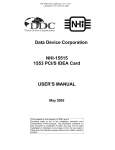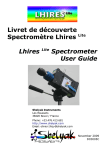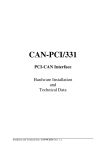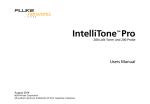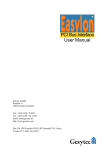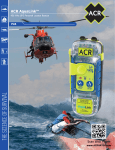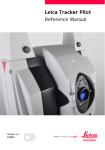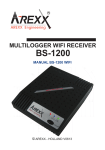Download Multi-Protocol PCI Board Instructions
Transcript
'DWD'HYLFH&RUSRUDWLRQ Multi-Protocol PCI Board Instructions Version 1.0 May 1999 The information provided in this document is believed to be accurate; however, no responsibility is assumed by''& for its use, and no license or rights are granted by implication or otherwise in connection therewith. Specifications are subject to change without notice. :LOEXU3ODFH%RKHPLD1< ''&_ VHUYLFH#GGFZHEFRP_ZZZGGFZHEFRP 1 TABLE OF CONTENTS Paragraph 1.0 1.1 1.2 2.0 2.1 2.2 2.3 2.4 3.0 4.0 4.1 4.2 4.3 5.0 INDEX Page Package Contents Features Description Installation Inspection System Requirements Coupling Transformer Jumpers Hardwired RT Address Jumpers Address Map Hardware Description Clock t Pci To Local Bus Bridge NHi-15382ET Terminals On-Line Help 2 3 3 4 4 4 4 5 6 7 8 8 8 8 1.0 Package Contents One PCI board Instructions Software Disks: WindowsNT/95/98 Filght Deck Software Qukstart.doc New1582.doc Flight Deck is menu driven GUI software which controls the PCI board and all the functions of the multi-protocol terminal(s) on the board. Qukstart.doc is a WORD97 document which demonstrates the use of Flight Deck. New1582.doc is the manual for the NHi-15382et terminal(s) which are on the PCI board. This is a WORD97 document. 2 1.1 FEATURES • Mil-Std-1553 and Multi-protocol PCI Interface Card • One or Two Independent Dual redundant Multi-protocol BC/RT/MTs on a PCI card • 1553B Notice 2,STANAG 3838,1760,3818, EFA, etc. • 64K x 16 Shared RAM for each dual BC/RT/MT • Programmable BC Gap Times • BC Frame Auto-Repeat • RT Data Buffering • RT Separate Broadcast Data Tables • Monitor Command Filtering • Simultaneous RT/Monitor • Programmable Interrupts • Low cost solution for 1553B protocol based testing • On board watchdog timer • Time tag with programmable resolution • Programmable real time clock • Switch selectable interrupt levels • Low power consumption 1.2 Description The NHI-15503 is a PCI card which contains one or two completely independent 1553 interfaces. Each interface is an NHi-15382ET multi-protocol MCM . which can operate as an RT, BC, or MT. Each ET includes two monolithic transceivers, a protocol asic and 64K wordsof shared RAM. Double buffering of the shared RAM enables simultaneous message preparation and 1553 bus transfers All modes of operation access data tables via pointers residing in RAM which facilitates multiple buffering. This allows buffers to change without moving data and promotes efficient use of RAM space. The data tables have programmable sizes and locations. The invisibility of memory when the card is not active prevents inadvertent access during power-on-self test of the PC or by any other process. 3 2.0 INSTALLATION 2.1 Inspection The card has been thoroughly tested and inspected before shipment. After removing the card from the packing container, please retain the container as it may be used to store the card when not installed in the computer. The packing container may be utilized in the event that the card has to be returned due to failure or damage. 2.2 System Requirements SYSTEM REQUIREMENTS PC with PCI Bus Windows95/98/NT Hard disk Color Monitor Follow these precautions before installing the card inside your PC. Remove power to the PC before opening the top cover. Make the necessary switch and jumper selections for your application as detailed in this manual and then plug the card into an available slot on the motherboard. The card has been delivered from the factory with the folowwing default settings: IRQ from the terminals are software disabled Buses are jumpered for Stub coupling(via jumper blocks), Hardwire RT address 01 and 02 for terminals 1 and 2 respectively(via jumper blocks). Follow the installation instructions in file LOAD95.TXT or LOADNT,TXT. REMOVE POWER TO THE PC WHEN REMOVING OR INSERTING THE CARD INTO THE PC. 2.3 Coupling Transformer Jumpers The card can be configured for either direct or transformer coupling via jumpers JP13JP20. For terminal 1: jumpers JP13 and JP14 are for Bus A, jumpers JP15 and JP16 are for Bus B For terminal 2: jumpers JP17 and JP18 are for Bus A, jumpers JP19 and JP20 are for Bus B 4 The jumper configuration for the coupling transformer for each terminal is shown below: Jumper Transformer Coupling Direct Coupling JP13 JP14 • • • • • • • • • • • • JP15 JP16 • • • • • • • • • • • • JP17 JP18 • • • • • • • • • • • • JP19 JP20 • • • • • • • • • • • • Note: In the above illustration, position the PCI card with the component side up and the Bus connectors are on your left. Both Bus A and Bus B of each terminal should be configured the same way to avoid any potential bus mismatch. 2.4 Hardwired RT Address Jumpers Each of the Terminals can be given a unique Remote Terminal(RT) hardwire address via jumper selection. The configuration for terminal 1 with an RT address of 1 and odd parity is shown below: JP3 Parity "1" "0" • • • JP2 A4 JP1 A3 JP12 A2 JP11 A1 JP10 A0 • • • • • • • • • • • • • • • 5 The configuration for terminal 2 with an RT address of 2 and odd parity is shown below: JP9 Parity "1" "0" • • • JP8 A4 JP7 A3 JP6 A2 JP5 A1 JP4 A0 • • • • • • • • • • • • • • • Note: In the above illustration, position the PCI card with the component side up and the Bus connectors are on your left. "1" is at the top of the jumper block. 3.0 ADDRESS MAP The following memory map information is not generally required by a user unless custom software is being developed for the NHi PCI card.. The NHi Filght Deck Windows software handles all memory allocation and accesses. Each terminal on the 15503 card appears to the host as 64K words of contiguous memory. The address map for each terminal is shown below. ADDRESS (in words) 0-29 Internal Control and Status registers 30 External RT address / Command outpin pins 31 Not Used 32-35 Not Used 64- 65535 Shared RAM (accessed on the Host I/O bus) The following address map table defines all addresses relevant to the user. The addresses are offsets from the base address as selected by the user. 6 ADDRESS CONTENTS/OPERATION Base + 0 Base + 1 Base + 2 Base + 3 Base + 3 Base + 3 Base + 4 Base + 4 Base + 4 Base + 5 Base + 6 Base + 7 Base + 8 Base + 8 Base + 9 Base + 10 Base + 11 Base + 12 Base + 13 Base + 14 Base + 15 Base + 16 Base + 17 Base + 18 Base + 19 Base + 20 Base + 21 Base + 22 Base + 23 Base + 24 Base + 25 Base + 26 Base + 27 Base + 28 Base + 29 Base + 30 Base + 30 Base + 31 Control Register Pointer Table Address Register Basic Status Register IMR (lower byte) IVR (upper byte) IRR (upper byte) IVR (lower byte) AVR (upper byte) Configuration Register 2 (upper byte, BC/MT only) RTC_ High RTC_ Low RTC Control Register FIFO Read FIFO Reset (both bytes) Configuration Register 1 Reserved Last Command Register Last Status Register Frame “A” (Msg List Addr)/ Block “A” Start Address Frame “A” Length (Msg List Len)/Block “A” End Addr Reset RT (both bytes) Frame “B” ( Msg List Addr)/ Block “B” Start Address Frame “B” Length/ Block “B” End Encoder Status Register Condition Register BC Frame Gap/ Word Monitor End of Frame Options Configuration Register 3 Message Monitor Address Filter 1 (0-15) Encoder Data Register * Encoder Data TX Request (both bytes) * Encoder CMD TX Request (both bytes) * Message Monitor Address Filter 2 (16-31) Word Monitor Last Address Block “A” Word Monitor Last Address Block “B” Reserved External RT Address Buffer (lower byte) Command Output Pins I/O Tag Register * In order to write to addresses 23, 24, and 25, the ET must be in loopback in the RT mode (see Control Register in the Enhanced Terminal Products User’s Manual for details). 7 R/W R/W R/W R/W R/W R W R/W R W R R R/W R W R/W R R R/W R/W W R/W R/W R R R/W R/W R/W R/W W W R/W R R R W R/W 4.0 HARDWARE DESCRIPTION 4.1 Clock A 20 Mhz oscillator (U4) is used to provide the required clocks for the NHi-15503 PCI Card. 4.2 PCI To Local Bus Bridge A PLX9050 chip is used as the PCI to local bus bridge. It interfaces with the two NHiET's and and Altera EPM7064 pld. The EPM7064 connects the local bus and control signals to each NHi-ET. 4.3 NHi-15382ET Terminals The PCI card contains two NHi-15382ET terminals which function as a BC, MT, RT or an MT/RT. See the NHi Enhanced Terminals Manual for a full description. 5.0 On-Line Help On-Line help is available for all menu items and dialog boxes. Use the left mouse button to drag the Question Mark(?) to the item requiring help; then release the button over that item. The help dialog will appesr in the upper left screen area. 8 RM ® I FI REG U ST Outside the U.S. - Call 1-631-567-5600 ERED DATA DEVICE CORPORATION REGISTERED TO: ISO 9001:2008, AS9100C:2009-01 EN9100:2009, JIS Q9100:2009 FILE NO. 10001296 ASH09 The first choice for more than 45 years—DDC DDC is the world leader in the design and manufacture of high reliability data interface products, motion control, and solid-state power controllers for aerospace, defense, and industrial automation. Inside the U.S. - Call Toll-Free 1-800-DDC-5757 Headquarters and Main Plant 105 Wilbur Place, Bohemia, NY 11716-2426 Tel: (631) 567-5600 Fax: (631) 567-7358 Toll-Free, Customer Service: 1-800-DDC-5757 Web site: www.ddc-web.com United Kingdom: DDC U.K., LTD Mill Reef House, 9-14 Cheap Street, Newbury, Berkshire RG14 5DD, England Tel: +44 1635 811140 Fax: +44 1635 32264 France: DDC Electronique 10 Rue Carle-Hebert 92400 Courbevoie France Tel: +33-1-41-16-3424 Fax: +33-1-41-16-3425 Germany: DDC Elektronik GmbH Triebstrasse 3, D-80993 München, Germany Tel: +49 (0) 89-15 00 12-11 Fax: +49 (0) 89-15 00 12-22 Japan: DDC Electronics K.K. Dai-ichi Magami Bldg, 8F, 1-5, Koraku 1-chome, Bunkyo-ku, Tokyo 112-0004, Japan Tel: 81-3-3814-7688 Fax: 81-3-3814-7689 Web site: www.ddcjapan.co.jp Asia: Data Device Corporation - RO Registered in Singapore Blk-327 Hougang Ave 5 #05-164 Singapore 530327 Tel: +65 6489 4801 The information in this Manual is believed to be accurate; however, no responsibility is assumed by Data Device Corporation for its use, and no license or rights are granted by implication or otherwise in connection therewith. Specifications are subject to change without notice.









